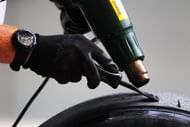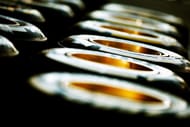A Red Bull Racing mechanic works on wheels and Pirelli tyres in the paddock during practice for the Bahrain Formula One Grand Prix on April 19, 2013 in Sakhir, Bahrain. (Getty Images)
It is that time of the year, the start of the long European leg of the Formula 1 season, when big teams are traditionally known to come up with significant upgrade packages and a chunk of updates to their cars. Cars that show genuine pace in Barcelona tend to carry forward the advantage for the remainder of the season.
The tyres this season have been the in the centre of a lot of attention, with teams still trying to wrap their heads around this issue of ‘Excessive Tyre Degradation.’ The root cause of all of this is quite obvious; the tyre compounds in use are comparatively softer than they used to be last year. The Soft compound this year can typically gain around 1-1.5 seconds over the Medium compound during Qualifying.
During the race, it can have a considerable performance advantage over Medium/Hard compound for a maximum of 4-6 laps, till it reaches its peak, after which its performance graph does a free fall. The issue here is not the free fall in its performance; rather, it is that window of optimum tyre performance that has become the talking point. Now, who decides the degree of degradation of a particular tyre compound is really mysterious.
Version 1: Pirelli makes its own decision regarding longevity of the tyre compounds they supply
Pirelli recently announced their decision of slightly tweaking the hard compound tyres for the remainder of the season. Now if people at Pirelli are solely responsible for the decision making regarding the compounds, why wouldn’t they prefer a much smoother run in the sport, considering the fact that their contract runs out this year. There has been a lot of criticism from various sections of the Formula 1 fraternity regarding current scenario, which certainly would not do any good to their popularity in the tyre market.
Version 2: Bernie and his men call the shots and Pirelli simply respond to his demands
This seems like a much more realistic version of how things stand. These tyres have made the races a lot more exciting to watch with a lot of strategy options available to the drivers before Qualifying. The significance of qualifying performance has dropped drastically from what it used to be a few years back. Gone are those days when you used to see drivers pitting in on the penultimate lap, just because the rules demanded it and not because of worn tyres. Yes, the races used to be exciting even then; it is just that these Mickey Mouse tyres have added to the drama of an already artificial ‘DRS-ed’ racing. The races have become more exciting. The money is flowing in. What else could matter for Bernie?

A Pirelli technician works on tyres in the paddock during practice for the European Formula One Grand Prix at the Valencia Street Circuit on July 24, 2011, in Valencia, Spain. (Getty Images)
Whether Pirelli play any role in deciding the longevity of a particular compound is questionable, but something which I hope isn’t questionable is the role they play in deciding the tyre allocation for the races.
Here are the tyres allocated to the teams for the first four races of the season.
| Grand Prix | Option | Prime |
| Australia | Super Soft | Medium |
| Malaysia | Medium | Hard |
| China | Soft | Medium |
| Bahrain | Soft | Hard |
Now how is the issue of tyre wear affecting the whole scheme of things:
Qualifying
Tyre management has become an important key, and one way drivers do so it is by doing a single lap run in Q3 instead of doing a banker lap on a scrubbed set. The banker times were mostly useless, but added another dimension to qualifying when you had those odd banker times remaining at the top in the end. What we see now is an empty track with drivers sitting it out in the pit for more than half of Q3 to have a single lap shoot out at the end. Even worse, if a driver decides to start on Prime tyres, he could even think about not having a Q3 run at all without losing much ground. That simply sums up the state of things.
Possible Alternatives:
i. Change the tyre allocation rules for qualifying and allow a fresh set for the race or bring back the multi compound Qualifying cum race tyres. It would encourage more Q3 running and would discourage drivers from skipping Q3 to get an advantage of starting on a fresher set on Sundays.
ii. Make Q3 running mandatory or have a grid penalty for the drivers skipping it. A driver who set hasn’t set a Q3 time has effectively not set a time in the FIA Qualifying Classifications, so why encourage this practice.
Race
The teams and drivers have the option of starting the race on the Option or Prime tyres with both having its set of advantages. The popular trend is to start on Option tyres, which gives the driver a better chance of qualifying higher up the order, but with the disadvantage of having to pit in early during the race.
Starting on Prime tyres gives an advantage of staying out for a longer first stint and having a real pace advantage in the final stint on Options over the Prime runners.

Pirelli tyres are seen in the paddock during qualifying for the Hungarian Formula One Grand Prix on July 28, 2012 in Budapest, Hungary. (Getty Images)
There is no doubt that these tyres have made the racing a lot more exciting. The amount of passing has increased with the drivers running with different tyre strategies and wear level throughout the race. It is a lot better than seeing a Button doing a 50-lap stint on a set of Softs on an abrasive Albert Park with absolutely no sign of tyre degradation. The races now are certainly better from a spectator’s point of view, if you manage to keep track with the fast pace of events.
The Car
There has been a lot of criticism about these tyres governing the performance of the car, or the drivers not being able to drive the car to its capabilities due to the tyres. Ferrari were very quick in responding to the situation by hiring former Bridgesone F1 chief Hirohide Hamashima back in January specifically to understand this year’s tyre compounds.
More than half of the teams have joined the bandwagon in criticizing the tyres, spearheaded by Red Bull. So weren’t these teams aware of the tyre specs they were going to use this season, or is this criticism just a case of reacting late? Ferrari and Lotus have adapted well to the changes and so far seem to have the most tyre friendly cars in the field.
Tyre wear and tyre management have always been among the crucial factors deciding the capabilities of a car and a driver. It is just that some teams and drivers claim that these factors have crossed a certain limit and are now interfering with the racing.
F1: It’s not always just about how quick you go, it’s sometimes about how long you can keep it going for…#LongerLastingRubber.
